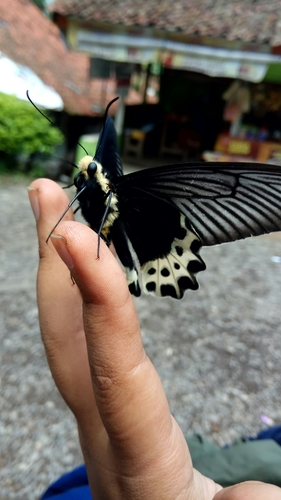Among Asia's Red-bodied and Black-bodied Swallowtails, with their black, red, or black-and-red heads, there is also a large dark-winged swallowtail with a white, or yellow, or pale pink head.
Whether we call it the Whitehead, or White-headed Swallowtail, neither form sounds very appealing in English. In Latin it's called Atrophaneura priapus, which sounds even worse. Priapus was sometimes worshipped but his worship was considered obscene. A subspecies within this species is called hageni, Hagen's Batwings. Some think hageni should be considered a separate species. (Hageni have red markings instead of pale yellow.) Some sources mention a subspecies dilutu, which has more of a uniform grayish color than black and white. Some think both subspecies should be considered subspecies of Atrophaneura luchti and/or A. sycorax.
Subspecies dilutus. As shown it looks as if it's faded in storage, but reportedly it looks faded while living, too.
Found in Burma, Malaysia, Sumatra, and Java, they seemed closer to the red-bodied swallowtails than to the black-bodied ones. Red patches on the other Atroophaneuras can fade to pink, orange, or white. On White Heads almost all of them are faded. The inside edge of the hind wings, especially in the male, may be outlined in red. The male's hind wings are lined with folds of pale skin that grow hairs, not scales, that release an odor by which other butterflies recognize him as he flies. Otherwise males and females are pretty much alike.
The wingspan is 4.5 to 6 inches. The butterflies are thought to live on Aristolochia and are usually found in warm, humid forests. They live in tropical regions where all the seasons feel like summer, and are found all through the year, but are most often found in August or September. The majority of findings occur "in Indonesia," according to n organization that didn't separate reports by islands.
Though not numerous, they are not known to be immediately endangered. They can be legally sold as "collection" pices, and unfortunately they often are.




No comments:
Post a Comment